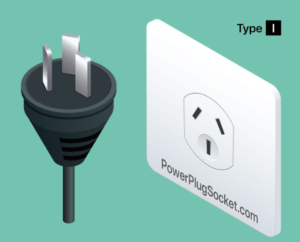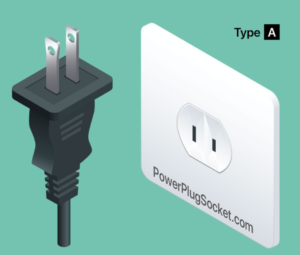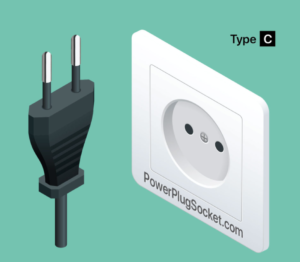Travelling overseas requires careful planning and preparation to ensure a smooth experience. And while you’re busy focusing on the big things, like checking your passport, packing and planning your itinerary, it’s easy to overlook a few details. For instance, will you be able to plug your devices in to charge or do you need an adapter?
What type of electrical plug does NZ use?

New Zealand uses Type I plugs and socket standard. Type I plugs have three flat pins, two of which are angled to form an inverted ‘V’. The other flat pin runs straight down underneath. So, why are there three pins?
The top pin is for the active (AKA hot or live) wire, which carries the current from the power source to the device you are using.
The middle pin is for the neutral wire. The neutral wire carries the current back from your device to the power source, completing the electrical circuit.
The final wire, which is connected to the bottom pin, is a ground wire. A ground wire is a safety feature and provides a path for current to safely dissipate into the ground in the event of a fault or short circuit.
Does Australia use the same type of electrical plug?
Fortunately for Kiwis, Australia also uses Type I plugs and socket standard, meaning you typically won’t need an adapter to charge your devices.
Voltage in NZ is 230/240V and is typically the same as voltage in Australia.
However, it’s always a good idea to double-check the voltage and frequency compatibility of your devices before plugging them in, as there might be some differences between countries.
What other countries have the same electrical plugs?
You might be surprised to know that there are a selection of other countries outside of Australia and New Zealand that use the same type of electrical plug. These countries include:
- Argentina
- China
- Fiji
- Papa New Guinea
- Samoa
- Tokelau
- Tonga
- Tuvalu
Which countries will I need an adapter in?
However, the majority of the world use different electrical plugs to NZ. With 15 types of domestic outlet plugs in use worldwide, there’s certainly a range of options, some of which are safer than others. Type A and Type C are the most commonly used electrical plugs in the world.
Type A*
Type A electrical plugs are ungrounded plugs that consist of two flat parallel prongs. These electrical plugs have a current rating of 15A and a voltage of 125V. Type A plugs are used by many countries including:
- USA
- Canada
- Mexico
- Japan
- Taiwan
Type C*
Type C electrical plugs (also known as Europlugs) have two round pins and do not include a grounding pin. These electrical plugs have a current rating of 2.5A and 250V. Type C plugs are used in many countries including:
- Most of Europe
- India
- Brazil
- Saudi Arabia
- United Arab Emirates
For a complete list of electrical plug type per country, click here.
Note that many countries now require grounded sockets to be installed in new buildings. Type A and Type C electric plugs are ungrounded, and are slowly being phased out for a safer option.
*Many countries use a mixed range of electrical plugs, which differ from region to region.
What are adapters?
An adapter acts as a bridge which allows you to connect your devices and plugs to different types of electrical outlets. Some adapters modify power or signal attributes, however, the majority simply adapt the shape of the outlet and plug so they can connect. If the voltage or frequency of the electricity in the country you’re visiting is different to NZ, and your adapter doesn’t convert this, you may need a voltage converter.
Many electrical stores offer universal adapters, which are compatible with any type of electrical plug and outlet.
Compare electricity providers with Canstar Blue
Finding affordable power involves shopping around. And to help you find the best value electricity retailer, Canstar Blue rates NZ power companies for customer satisfaction and value for money, see the table below for some of the results, or you can click on the button below for the full results of our survey.
Canstar Blue’s latest review of NZ power companies compares them on customer satisfaction. The table below is an abridged version of our full results, available here.
^ By clicking on a brand or 'details' button, you will leave Canstar Blue and be taken to either a product provider website or a Canstar Blue NZ brand page. You agree that Canstar Blue NZ’s terms and conditions apply (without limitation) to your use of this service,to any referral to a product provider from our website, and any transaction that follows. Canstar Blue may earn a fee for referrals from its website tables, and from sponsorship (advertising) of certain products. Payment of sponsorship fees does not influence the star rating that Canstar Blue awards to a sponsored product. Fees payable by product providers for referrals and sponsorship may vary between providers, website position, and revenue model. Sponsorship fees may be higher than referral fees. Sponsored products are clearly disclosed as such on website pages. They may appear in a number of areas of the website such as in comparison tables, on hub pages and in articles. Sponsored products may be displayed in a fixed position in a table, regardless of the product’s rating, price or other attributes. The table position of a sponsored product does not indicate any ranking, rating or endorsement by Canstar Blue. See How we are funded for further details.
Canstar Blue NZ Research finalised in April 2023, published in June 2023.
See Our Ratings Methodology
Compare electricity providers with Canstar Blue!
About the author of this page
This report was written by Canstar Content Producer, Caitlin Bingham. Caitlin is an experienced writer whose passion for creativity led her to study communication and journalism. She began her career freelancing as a content writer, before joining the Canstar team.
Enjoy reading this article?
You can like us on Facebook and get social, or sign up to receive more news like this straight to your inbox.
By subscribing you agree to the Canstar Privacy Policy



Share this article